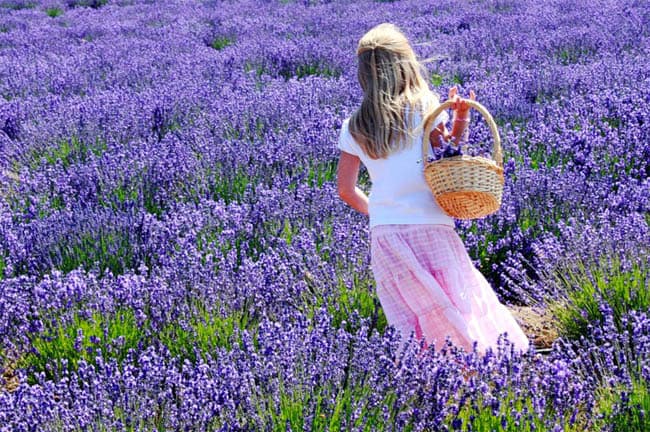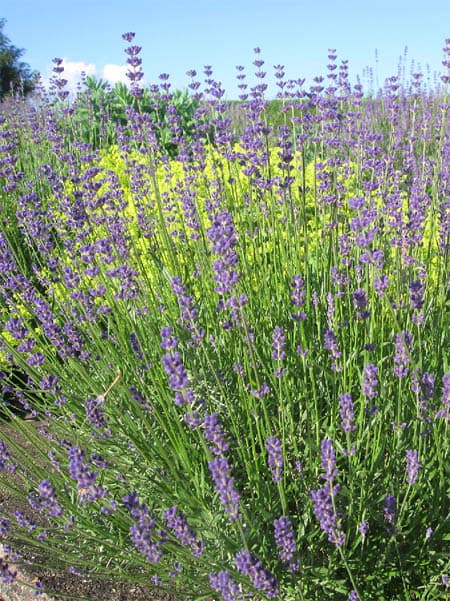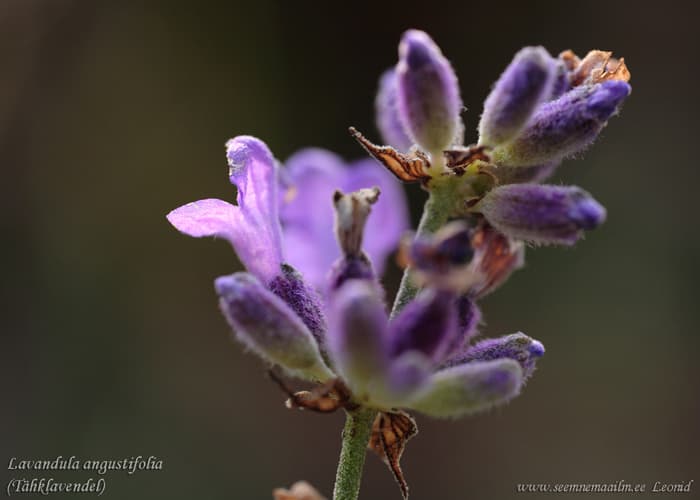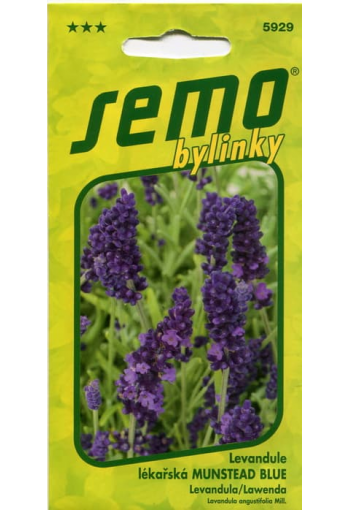Aromatic, medicinal, decorative.
Beautiful, perennial, strongly branched and abundantly flowering shrub. A special, unique aroma of flowers gives an extremely pleasant smelling essential oil. Preparations based on lavender act as an antiseptic, sedative and antispasmodic. They have a wide range of other useful properties. Lavender flowers are a favorite material for filling "sleepy pillows" and a moth repellant. Inflorescences begin to collect as soon as the flowers bloom.


An evergreen shrub growing to 1.2m by 1m . It is hardy to zone 5. It is in leaf all year, in flower from July to September, and the seeds ripen from August to October. The scented flowers are hermaphrodite (have both male and female organs) and are pollinated by Bees and Lepidoptera (Moths & Butterflies). It is noted for attracting wildlife. We rate it 4 out of 5 for usefulness.
The plant prefers light (sandy), medium (loamy) and heavy (clay) soils and requires well-drained soil. The plant prefers acid, neutral and basic (alkaline) soils and can grow in very alkaline and saline soils. It cannot grow in the shade. It requires dry or moist soil and can tolerate drought. The plant can tolerate maritime exposure.
Cultivar Hidcote Hedge, Cultivated Beds, In Walls, In South Wall, In East Wall, In West Wall.
Cultivar Munstead: Hedge, Cultivated Beds, In Walls, In South Wall, In East Wall, In West Wall.
Cultivar Sharon Roberts: Hedge, Cultivated Beds, In Walls, In South Wall, In East Wall, In West Wall.
Edible Uses Condiment; Tea. Leaves, petals and flowering tips - raw. Used as a condiment in salads, soups, stews etc. They provide a very aromatic flavour and are too strong to be used in any quantity. The fresh or dried flowers are used as a tea. The fresh flowers are also crystallized or added to jams, ice-creams, vinegars etc as a flavouring. An essential oil from the flowers is used as a food flavouring.
Medicinal Uses Disclaimer Antihalitosis; Antiseptic; Antispasmodic; Aromatherapy; Aromatic; Carminative; Cholagogue; Diuretic; Nervine; Sedative; Stimulant; Stomachic; Tonic.
Lavender is a commonly used household herb, though it is better known for its sweet-scented aroma than for its medicinal qualities. However, it is an important relaxing herb, having a soothing and relaxing affect upon the nervous system. The flowering spikes can be dried and used internally in a tincture, though the extracted essential oil is more commonly used. The essential oil is much more gentle in its action than most other essential oils and can be safely applied direct to the skin as an antiseptic to help heal wounds, burns etc. An essential oil obtained from the flowers is antihalitosis, powerfully antiseptic, antispasmodic, aromatic, carminative, cholagogue, diuretic, nervine, sedative, stimulant, stomachic and tonic. It is not often used internally, though it is a useful carminative and nervine. It is mainly used externally where it is an excellent restorative and tonic - when rubbed into the temples, for example, it can cure a nervous headache, and it is a delightful addition to the bath-water.
Its powerful antiseptic properties are able to kill many of the common bacteria such as typhoid, diphtheria, streptococcus and Pneumococcus, as well as being a powerful antidote to some snake venoms. It is very useful in the treatment of burns, sunburn, scalds, bites, vaginal discharge, anal fissure etc, where it also soothes the affected part of the body and can prevent the formation of permanent scar tissue. The essential oil is used in aromatherapy. Its keyword is Immune system.
Other Uses Essential; Hedge; Incense; Pot-pourri; Repellent. The essential oil that is obtained from the flowers is exquisitely scented and has a very wide range of applications, both in the home and commercially. It is commonly used in soap making, in making high quality perfumes (it is also used in Eau de Cologne), it is also used as a detergent and cleaning agent, a food flavouring etc and as an insect repellent.
When growing the plant for its essential oil content, it is best to harvest the flowering stems as soon as the flowers have faded. Yields of 0.8 - 1% of the oil are obtained. The aromatic leaves and flowers are used in pot-pourri and as an insect repellent in the linen cupboard etc. They have been used in the past as a strewing herb in order to impart a sweet smell to rooms and to deter insects. The leaves are also added to bath water for their fragrance and therapeutic properties. They are also said to repel mice. The flowering stems, once the flowers have been removed for use in pot-pourri etc, can be tied in small bundles and burnt as incense sticks.
Lavender can be grown as a low hedge, responding well to trimming. There are several varieties, such as Hidcote Variety, Loddon Pink and Folgate Blue that are suitable for using as dwarf hedges 30 - 50 cm tall. Cultivation details Succeeds in almost any soil so long as it is well-drained and not too acid. Prefers a sunny position in a neutral to alkaline soil.
Prefers a light warm dry soil. When grown in rich soils the plants tend to produce more leaves but less essential oils. Established plants are drought tolerant. Plants are very tolerant of salt wind exposure. When growing for maximum essential oil content, the plant must be given a very warm sunny position and will do best in a light sandy soil, the fragrance being especially pronounced in a chalky soil. Plants are hardy to between -10 and -15°c.
Lavender is a very ornamental plant that is often grown in the herb garden and is also grown commercially for its essential oil. There are several named varieties. Not a very long-lived plant, it can be trimmed to keep it tidy but is probably best replaced every 10 years. Any trimming is best done in spring and should not be done in the autumn since this can encourage new growth that will not be very cold-hardy. A good bee plant, also attracting butterflies and moths. Lavender makes a good companion for most plants, growing especially well with cabbages.
Propagation Seed - sow spring in a greenhouse and only just cover the seed. It usually germinates in 1-3 months at 15°c. When large enough to handle, prick the seedlings out into individual pots and grow them on in the greenhouse or cold frame for their first winter, planting them out in late spring after the last expected frosts.
Cuttings of half-ripe wood 7-10 cm with a heel, July/August in a frame. Usually very east, a high percentage will root within a few weeks. Grow them on in the greenhouse for their first winter and plant them out in late spring after the last expected frosts. Cuttings 7 cm with a heel succeed at almost any time of the year. Layering.

English lavender, true lavender. Bot. syn.: Lavandula angustifolia P. Mill, Lavandula delphinensis Jord ex Billot, Lavandula officinalis Chaix., Lavandula spica L., Lavandula vera DC.
Powdered lavender is sprinkled on prepared dishes, just as many dishes are seasoned with ground black pepper ...
* You can make your own spice from lavender - "lavender salt", which is perfect for using as a seasoning for meat and vegetable dishes. To do this, you will need half a cup of sea salt, which must be ground in a mortar and mortar with one teaspoon of dried lavender flowers. If your kitchen is located on the south side, then you can easily grow fragrant lavender in your pot right on the windowsill. And then you will always have fresh lavender on hand for making fragrant tea, especially since the famous lavender teas have long been famous for their calming and relaxing effect.
You can grow lavender on the windowsill from February to November as an ordinary houseplant, and send it to “sleep” in the basement or on the balcony for the winter.
Lavender exudes an attractive pleasant smell that promotes calm and relaxation. Having a positive effect on the nervous system, it is useful for migraines, excitability, insomnia and stress. So that the "lavender mood" does not leave you under any circumstances, you can make an "aroma bag" from a dried bunch of lavender. To do this, it is necessary to cut off the inflorescences immediately after the start of its flowering, at the stage when all the flowers in the spikelet are coloured and have not faded. The stems are tied into tight bundles and hung vertically in a dry, cool place, out of direct sunlight. Such bouquets can be arranged in small vases or filled with small aroma bags with flowers alone, which retain an intense smell for more than one year.











